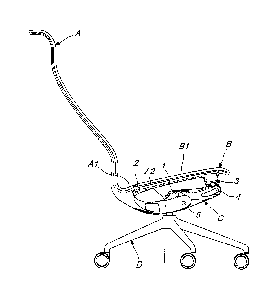Some of the information on this Web page has been provided by external sources. The Government of Canada is not responsible for the accuracy, reliability or currency of the information supplied by external sources. Users wishing to rely upon this information should consult directly with the source of the information. Content provided by external sources is not subject to official languages, privacy and accessibility requirements.
Any discrepancies in the text and image of the Claims and Abstract are due to differing posting times. Text of the Claims and Abstract are posted:
| (12) Patent Application: | (11) CA 3036793 |
|---|---|
| (54) English Title: | OFFICE CHAIR WITH SYNCHRONOUSLY MOVABLE BACKREST AND SEAT |
| (54) French Title: | CHAISE DE BUREAU EQUIPEE D`UN DOSSIER ET D`UN SIEGE DEPLACABLES DE MANIERE SYNCHRONISEE |
| Status: | Examination |
| (51) International Patent Classification (IPC): |
|
|---|---|
| (72) Inventors : |
|
| (73) Owners : |
|
| (71) Applicants : |
|
| (74) Agent: | ROBIC AGENCE PI S.E.C./ROBIC IP AGENCY LP |
| (74) Associate agent: | |
| (45) Issued: | |
| (22) Filed Date: | 2019-03-13 |
| (41) Open to Public Inspection: | 2019-12-14 |
| Examination requested: | 2024-03-07 |
| Availability of licence: | N/A |
| Dedicated to the Public: | N/A |
| (25) Language of filing: | English |
| Patent Cooperation Treaty (PCT): | No |
|---|
| (30) Application Priority Data: | ||||||
|---|---|---|---|---|---|---|
|
A chair in which a synchronized mechanism, fixed on a telescopic
post of a base, supports and renders interdependent rigid elements and
which, define respectively the backrest and the seat of the chair and are
mutually hinged at a first point, i.e. along a horizontal axis perpendicular
to
the longitudinal centerline plane of the seating space, which is entirely
defined by a single curved line obtained by joining the rigid elements and
which are adapted for this purpose.
Note: Claims are shown in the official language in which they were submitted.
Note: Descriptions are shown in the official language in which they were submitted.

2024-08-01:As part of the Next Generation Patents (NGP) transition, the Canadian Patents Database (CPD) now contains a more detailed Event History, which replicates the Event Log of our new back-office solution.
Please note that "Inactive:" events refers to events no longer in use in our new back-office solution.
For a clearer understanding of the status of the application/patent presented on this page, the site Disclaimer , as well as the definitions for Patent , Event History , Maintenance Fee and Payment History should be consulted.
| Description | Date |
|---|---|
| Letter Sent | 2024-03-11 |
| Request for Examination Received | 2024-03-07 |
| Request for Examination Requirements Determined Compliant | 2024-03-07 |
| All Requirements for Examination Determined Compliant | 2024-03-07 |
| Small Entity Declaration Determined Compliant | 2024-03-07 |
| Small Entity Declaration Request Received | 2024-03-07 |
| Common Representative Appointed | 2020-11-07 |
| Application Published (Open to Public Inspection) | 2019-12-14 |
| Inactive: Cover page published | 2019-12-13 |
| Common Representative Appointed | 2019-10-30 |
| Common Representative Appointed | 2019-10-30 |
| Inactive: First IPC assigned | 2019-03-26 |
| Inactive: IPC assigned | 2019-03-26 |
| Inactive: IPC assigned | 2019-03-26 |
| Inactive: Filing certificate - No RFE (bilingual) | 2019-03-26 |
| Inactive: IPC assigned | 2019-03-26 |
| Inactive: Applicant deleted | 2019-03-21 |
| Application Received - Regular National | 2019-03-19 |
There is no abandonment history.
The last payment was received on 2024-03-04
Note : If the full payment has not been received on or before the date indicated, a further fee may be required which may be one of the following
Patent fees are adjusted on the 1st of January every year. The amounts above are the current amounts if received by December 31 of the current year.
Please refer to the CIPO
Patent Fees
web page to see all current fee amounts.
| Fee Type | Anniversary Year | Due Date | Paid Date |
|---|---|---|---|
| Application fee - standard | 2019-03-13 | ||
| MF (application, 2nd anniv.) - standard | 02 | 2021-03-15 | 2021-03-01 |
| MF (application, 3rd anniv.) - standard | 03 | 2022-03-14 | 2022-02-28 |
| MF (application, 4th anniv.) - standard | 04 | 2023-03-13 | 2023-02-27 |
| MF (application, 5th anniv.) - standard | 05 | 2024-03-13 | 2024-03-04 |
| Request for examination - small | 2024-03-13 | 2024-03-07 |
Note: Records showing the ownership history in alphabetical order.
| Current Owners on Record |
|---|
| REXSITT ITALIA S.R.L. |
| Past Owners on Record |
|---|
| MASSIMO COSTAGLIA |